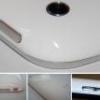
Google Nexus
#91

Δημοσίευση 17/02/2010 - 17:30
Θα ξεκεινησω απαντωντας σου αναποδα!! Οπως βλεπουμε στο test ¨πηγη¨ αλαζωντας το "viewport" size του NexusOne σε αυτο του iPhone3GS ¨480×320¨το αποτελεσμα ειναι το ιδιο! 21fps! ( image per sec. )
Βλεπουμε λοιπον λογω της κακης εκμεταλευσης του GPU "fill-rate limited" η αποδοσις του μενουνε η ιδιες!
Απο την πλευρα της η Apple, και κατα την γνωμη μου παντα!! δεν βλεπει το ενδιαφερων να αλαξει την αναλυση της χωρις πρωτα να ειναι σιγουρη για το αποτελεσμα!!
Μην ξεχναμε οτι για την Apple καθε επιπλεων αναλυση ( και οχι μονο ) σημαινει μειωση της μπαταριας!!! και επιπλεουν κοστους , αμα φτασουμε μεχρι την αλαγη της οθονης! κατη που δεν αποκλειεται απο την Apple!
Φιλικα
∼ Να είσαι ο εαυτός σου, όλοι οι άλλοι ρόλοι είναι πιασμένοι ∼
Ad
#92

Δημοσίευση 18/02/2010 - 01:35
#93

Δημοσίευση 18/02/2010 - 02:17
#94

Δημοσίευση 18/02/2010 - 19:29
I bought new google nexus for me and want to give a dashing look by an elegant good skin , So which website is best according to you for nice skins?
google nexus one skins
#95

Δημοσίευση 18/02/2010 - 19:46
Google Nexus One invisibleSHIELD
#96

Δημοσίευση 22/02/2010 - 19:57
 Google Nexus One OLED Display Shoot-Out.jpg 154,99KB
29 λήψεις
Google Nexus One OLED Display Shoot-Out.jpg 154,99KB
29 λήψεις
Color Depth and Granularity: Only 16-bits with Just 32 or 64 Intensity Levels
An absolutely shocking discovery is that the Nexus One only uses 16-bit color, so Red and Blue only have 32 possible intensity levels and Green only has 64 possible intensity levels. This is common on cheap low-end devices, but it is unacceptable for an expensive high-performance “Super Phone” that Google claims it to be. All screen colors are derived from intensity mixtures of the RGB primaries - with so few levels to work with the colors are coarse and inaccurate, which produces quite noticeable false contouring in many images and photos. Because Green has twice the number of levels as Red and Blue it has a finer intensity scale, which introduces combinations of Green and Magenta tints into images because Green can make intensity steps that Red and Blue cannot. Most computer, HDTV and mobile displays, including the iPhone, have at least 18-bit color and then often emulate full 24-bit color with dithering, providing 256 intensity levels for Red, Green and Blue, which produces a nice color and intensity scale without the ugly artifacts. Figure 1 shows the coarse intensity scale and the resulting false contouring in both a photograph and test pattern. Hopefully, Google will upgrade the Nexus One to full 24-bit color soon.
Display Image Quality, Colors and Artifacts:
Excellent for Text, Icons and Menu Graphics, but Poor for Images and Awful for Resolution Scaling
The high resolution, high pixel density OLED display on the Nexus One is beautiful, even stunning on first view, but it has lots of color and gray scale accuracy errors and lots of display artifacts (which is anything that appears in any on-screen image that should not be there) and results from hardware, firmware or software processing errors. Some of these issues are unimportant for many phone functions, but the accuracy of photographic images is severely impacted, as are computer content-like images with fine detail. In particular, text, icons and menu graphics generated by the Android OS are all outstanding, very sharp, with excellent PenTile sub-pixel rendering. On the other hand, in the important category of images, pictures and photographs from external sources, whether they be from digital cameras or web content, are rendered poorly and inaccurately, with over-saturated colors, bad color and gray-scale accuracy, large color and gray-scale tracking errors, calibration errors, lots of image noise from excessive edge and sharpness processing, and many artifacts. See the NASA Photo in Figure 1 for an example. Note that this screen shot does not fully capture all of the incredible noise on the Nexus One display. Another absolutely shocking discovery are the awful artifacts and very poor quality of the images that result from the resolution scaling that is used by the Android OS to import images so they fit on the native 800x480 resolution of the display. This is a critical function and the results indicate a laughably primitive scaling algorithm, with lots of dropped pixel content, color fringing, and moirés.
Measurements and Test Pattern Tests Summary: Lots of Shortcomings, Problems and Artifacts
The following is a brief summary of the main results of the Measurements and Test Pattern Tests, which follow in separate sections below with lots of additional background information and explanations.
1.The Peak White Brightness of 229 cd/m2 is poor and insufficient for a mobile display that will be frequently used in high ambient lighting. This makes the display hard to read, especially outdoors. And forget about seeing anything on-screen anywhere near sunlight…
2.The Black Brightness is outstanding, only 0.0035 cd/m2, which is so dark it is hard to measure or even detect by eye in the dark, but note that the Black Brightness is only relevant for dark viewing environments.
3.The Contrast Ratio, which is only relevant for low ambient lighting, is 65,415, which is outstanding, and the highest we have ever measured for a production display. Don’t confuse this true Contrast Ratio with the tremendously inflated Dynamic Contrast Ratios that are published by many manufacturers.
4.The Screen Reflectance, which is the most important specification for a mobile display used in high ambient lighting, is 15.5 Percent, which is relatively high, washes out the images, and makes it hard to see what is on the screen in bright viewing environments. Together with a low Peak Brightness this makes the Nexus One a poor performer in bright situations.
5.The High Ambient Light Contrast Rating of 15 is relatively low, so the Nexus One display is not good under high ambient lighting. For all mobile devices the High Ambient Light Contrast Rating is much more important than the low ambient light Contrast Ratio.
6.The Nexus One uses Dynamic Color and Dynamic Contrast to automatically jazz up and “enhance” the images by stretching and exaggerating the colors and intensity scale. It is similar to the Vivid mode found in many digital cameras and HDTVs. Since it distorts the images it ‘s a bad idea and should be made optional.
The Viewing Tests: Gaudy Picture Quality
We compared the Nexus One side-by-side to a calibrated Professional Sony High Definition Studio Monitor using a large set of DisplayMate Calibration and Test Photographs. All of the photos on the Nexus One had way too much contrast and color saturation, to the point of appearing gaudy, particularly faces and well known objects such as fruits, vegetables, flowers, grass, even a Coca-Cola can. Photos that include very color saturated objects, such as a fire engine, were in some cases painful to look at. Many photos showed readily apparent color and intensity false contouring and image noise from excessive processing. These effects are similar to setting an HDTV to a Vivid picture mode and then turning up the Color and Sharpness Controls. The punchy and excessively vibrant looking images on the Nexus One may initially get lots of oohs and aahs, like in many of the early reviews, but after a while the gaudy looking images will become tiresome and unpleasant.
Factory Calibration and Quality Control: Very Poor
OLED displays are at the leading edge of display technology – they are still under development and still being perfected as a production display for use in consumer products. That’s interesting, but they still need to be judged in comparison to LCDs, which are the dominant display technology in all current mobile devices. In that regard, if the Nexus One display were an LCD it would rank among the worst displays we have ever seen in a shipping product. Some of this is undoubtedly due to poor integration of the display hardware with the Android OS and software. Much of it, however, is simply due to very poor factory calibration and quality control, especially with the lack of any credible color and gray scale calibration. Most likely the display sub-assembly was just slapped in as-is into the phone, which is common in factories that are concerned with maximizing volume and minimizing production time and costs. That works fine for cheap displays in text-only based devices, but fails miserably for displays that are expected to deliver quality images for photo, video and web content, like the Nexus One…
#97

Δημοσίευση 22/02/2010 - 20:04
#98

Δημοσίευση 24/02/2010 - 00:06
Συνημμένα αρχεία
#99

Δημοσίευση 25/02/2010 - 02:30
Συνημμένα αρχεία
#100

Δημοσίευση 25/02/2010 - 10:50
- "Our own tests show that video can be played for well over 3 hours over Wi-Fi from YouTube in H.264 (Baseline 1.2)."
If you think that sounds good, note that the Nexus One is rated for 7 hours of video playback time.
[via daringfireball]
#101

Δημοσίευση 25/02/2010 - 14:55
Το 3GS που είναι rated για 10 ώρες video ( http://www.apple.com/iphone/specs.html ) πόσες ώρες playback βγάζει και μάλιστα OVER WIFI?
#102

Δημοσίευση 11/03/2010 - 02:03
#103

Δημοσίευση 11/03/2010 - 10:56
#104

Δημοσίευση 24/03/2010 - 22:10
Συνημμένα αρχεία
#105

Δημοσίευση 25/03/2010 - 16:17
Συνημμένα αρχεία
Ad
Χρήστες που διαβάζουν αυτό το θέμα: 6
0 μέλη, 6 επισκέπτες, 0 ανώνυμοι χρήστες















